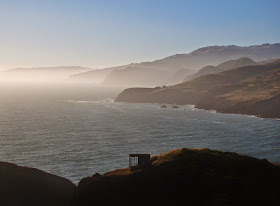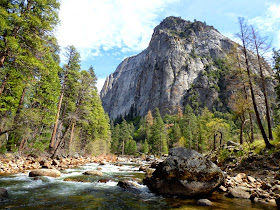There is a very strange looking meadow in the Sierra Nevada foothills 700 feet above the Tuolumne River. Bedrock around here is generally poorly exposed and deeply weathered. The region is one of gentle topography, with low hills and broad open valleys. But in this meadow, the rocks are barren and unweathered, looking as if they were recently quarried. And in a sense they have. A river once flowed here once. And I mean "once" in the most literal sense. It was here only once. This is one of the few places where one can see evidence of an extraordinary event, the flood of 1997. It was an event expected to happen here on average once every 250 years or so.

I was pondering the floods of 1997 because I visited Don Pedro Reservoir the other day and saw just how low the lake level has fallen after four years of crippling drought. The lake stands at about 35% of capacity, with around 800,000 acre feet of water remaining. The lake will be considered a "dead pool" (too low to produce hydroelectricity) if it gets as low as 300,000 acre feet. There isn't much danger of flooding this year with the snowpack sitting at 5% of normal.
Don Pedro Reservoir stores water for the Modesto and Turlock Irrigation Districts, and also serves as storage for Hetch Hetchy Reservoir water bound for San Francisco. The earth-fill dam stands 580 feet high and inundates 26 miles of the Tuolumne River, which flows out of Yosemite National Park. The dam was built for irrigation storage, hydroelectric power generation, recreation and...flood control.
The water year of 1996-1997 was unusual to say the least. A series of large storms in December had built up a record or near-record snowpack in the Yosemite high country. Then a New Years Day Pineapple Express storm took aim at central California. The warm, moist atmospheric river flowed over the Central Valley dropping only a few inches of rain, but when it hit the mountains, it poured as much as
three feet of rain at elevations as high as 10,000 feet, and onto the record snowpack.
Don Pedro Reservoir was at the proper level for normal flash flood conditions, with about 300,000 acre feet of storage available. But the water coming downstream was not normal. At the peak, the rivers flowed into the lake at an unbelievable rate of 130,000 cubic feet per second. To put this number into perspective, the Tuolumne River is considered to be at flood stage at 9,000 cubic feet per second. The dam operators had a big problem and they knew it. They had to purposely flood the cities downstream to prevent a total catastrophe. They ramped up the power generating turbines, and for the first time in the dam's history, they opened the floodgate.

The floodgate didn't open into the Tuolumne River. It faced a meadow that had never before had a river flowing through. As can be seen from the pictures here, the meadow was hit by a flood of gigantic proportions. Ripping away soil and solid rock, the river quarried a channel forty feet deep in the space of three days. And it barely worked. At the highest point, the reservoir was flowing uncontrolled over a concrete weir that was the never supposed to be topped. The water was only a foot deep, but spread out over several hundred feet, it ripped away soil, rock, and the highway that passed below the floodgates.
The city of Modesto and others downstream experienced the greatest flood in their history, with top flows of around 60.000-70,000 cubic feet per second. But if Don Pedro Dam had not been there, the towns would have been hit with a flood twice as big.
Today, the scene is a complete contrast to 1997. I was standing on a hill above the dam looking at the floodgate from the backside. The entire region in the picture below would be inundated if the reservoir was full. As you can see, there was no water in sight.
Only one flood in recorded history could possible compare with 1997. That was the flood of 1861-62, which was so large that parts of the Great Valley turned into a lake for weeks. Sacramento was abandoned as the state capitol for months while the waters subsided. No gauges were present on any of the rivers so we don't know how the numbers compare, but considering that 1997 was considered a 250 year flood (a 1/250 chance of occurring in any one year), it must have been truly extraordinary.
And that's the way it is with water in California. We rarely have a "normal" year. It tends to be a feast or famine kind of environment. Frankly, we're hoping for a "feast" next year, and for several years after, but the record kind of leans the other way. In the last 2,000 years, California has experienced two "megadroughts" that lasted a century each. The watermasters in our fair state have been consuming lots of antacids lately, I suspect.
The pictures of the flooding in 1997 are courtesy of the visitor center at Don Pedro Reservoir. I experienced the flooding, but I was in Waterford and Modesto. It was a sight. A normally dry creek in the middle of town called, creatively, Dry Creek was flooding at 9,000 cubic feet per second. As noted before, that's flood stage for the Tuolumne River. And Dry Creek was a small tributary. It truly was a one-of-a-kind event.
POSTSCRIPT: Turlock Irrigation District has a video of the flooding of the Tuolumne at
https://www.youtube.com/watch?v=94sAz3gZciQ&feature=youtu.be&a. Stunning footage...

























%2Bb.jpg)






























